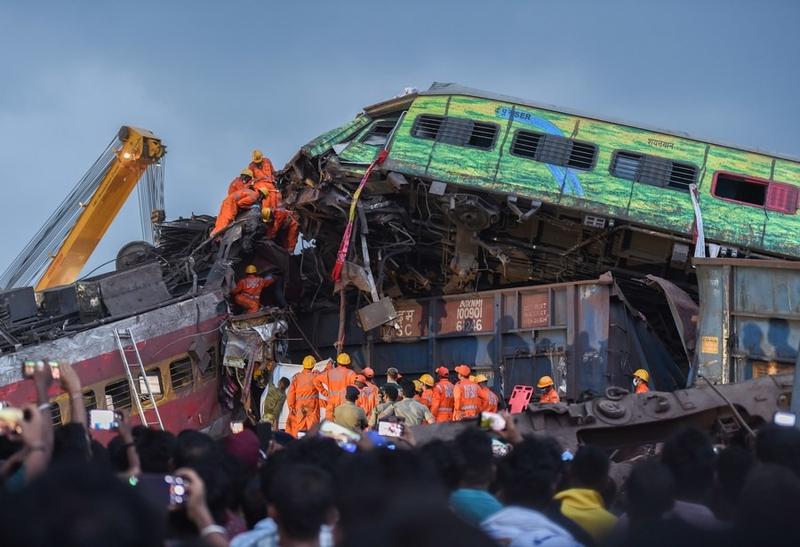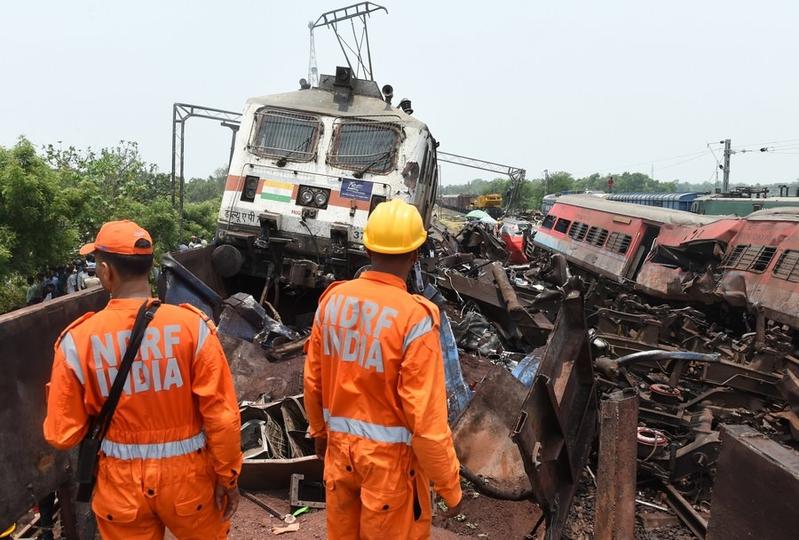 Rescuers work at the site of a train collision in Balasore district of eastern Indian state of Odisha June 3, 2023. (PHOTO / XINHUA)
Rescuers work at the site of a train collision in Balasore district of eastern Indian state of Odisha June 3, 2023. (PHOTO / XINHUA)
The mangled coaches of the trains climbed on top of each other. One was overturned. Their wheels were up. A few coaches fell into a nearby water body. One engine was seen sitting on top of a freight car.
Amid all this, a heap of dead bodies covered in white cloth – many are limbless – lay scattered. Cries and screams of survivors and mourners were heart-wrenching. And over everything was the sound of the sirens of ambulances. There had been a blood bath on tracks, as it were.
After reviewing the restoration work at the collision site, India’s railway minister Ashwini Vaishnaw on Sunday said: “We have identified the root cause of the train accident and the people responsible for it. Accident happened due to a change in electronic interlocking. Right now our focus is on restoration.”
In what has been described as the third deadliest crash in the history of Indian railways and the worst in this millennium, at least 288 people have been killed and more than 800 injured
In what has been described as the third deadliest crash in the history of Indian railways and the worst in this millennium, at least 288 people have been killed and more than 800 injured.
The June 2 crash involved three trains. It was reported around 7pm local time, the Coromandel Express, which runs from Kolkata to Chennai, hit the derailed bogies of a few coaches of Yashwantpur-Howrah Express which crashed and fell on the opposite track. A freight train was also said to be involved in the accident.
Xi extends condolences over deadly train accident in India
In matter of seconds on Friday evening, the Bahanaga Bazar station off a coastal town called Balasore in India’s eastern province of Odisha conjured up a deathly collage. It is about 171 kilometers northeast of Bhubaneswar, the capital city of Odisha state.
Witnesses said one train rammed into another lifting its carriages high into the air, then twisting and finally falling off the tracks.
“The force with which the trains collided resulted in several coaches being crushed and mangled,” Atul Karwal, chief of the National Disaster Response Force (NDRF) was by quoted ANI, a news agency, as saying.
 Rescuers work at the site of a train collision in Balasore district in the eastern Indian state of Odisha, June 3, 2023. (PHOTO / XINHUA)
Rescuers work at the site of a train collision in Balasore district in the eastern Indian state of Odisha, June 3, 2023. (PHOTO / XINHUA)
“At least 10-15 people fell on me when the accident happened and everything went haywire. I was at the bottom of the pile,” ANI quoted a survivor as saying. “When I came out, I saw someone had lost their hand, someone had lost their leg, while someone's face got distorted."
By June 4, all surviving passengers trapped inside the mangled coaches were taken to safety. Rescue teams, health workers, police, and fire service and disaster response force personnel carried out rescue operations immediately after the accident.
The Indian Air Force has sent Mi-17 helicopters to aid the rescue efforts, which continued until late Saturday afternoon. All the injured passengers were shifted to hospitals.
Prime Minister Narendra Modi held a meeting in New Delhi on the train crash Saturday morning. In the evening, he visited Balasore and also visited the wounded in hospital. Minister Vaishnaw participated and ordered a high-level investigation.
READ MORE: At least 261 dead in train accident in India's Odisha state
In a tweet, Modi said, “Distressed by the train accident in Odisha. In this hour of grief, my thoughts are with the bereaved families. May the injured recover soon… Rescue ops (operations) are underway at the site of the mishap and all possible assistance is being given to those affected."
Improving transport infrastructure tops Modi’s list of priorities. In recent times, Modi has inaugurated Vande Bharat, a semi-high-speed train.
Experts told China Daily the tragedy came as a fresh reminder of India’s need for a foolproof security system for trains.
The mishap of this scale should serve as an eye-opener, said G K Mohanty, former Chief Operations Manager of India’s South Eastern Railway.
“While we talk about high-speed trains, we must to take a fresh look at the ground realities. Do we have the right infrastructure? Are our systems geared to handle high-speed trains? In developed countries, high-speed corridors are fenced off. But in India, we have still have tracks that are easily accessible,” Mohanty said.
“I am inclined to believe that sometime, somewhere there has been a maintenance failure,” he added.
 Rescuers work at the site of a train collision in Balasore district in the eastern Indian state of Odisha, June 3, 2023. (PHOTO / XINHUA)
Rescuers work at the site of a train collision in Balasore district in the eastern Indian state of Odisha, June 3, 2023. (PHOTO / XINHUA)
As for the 2 June tragedy, Mohanty suspects a signal failure: If India really want to take our railway system and network to the top level of excellence, maintenance of infra and assets is a must.
DC Mitra, a former managing director of Rail Vikas Nigam Ltd said, “We aren’t perhaps paying enough attention to the needs for maintenance.”
According to him, every signal is operated through a system of relays, and a signal may have 30 relays attached to it. Relay rooms are supposed to be air-conditioned, and relays work properly only at temperatures below 25 degrees Celsius, Mitra said.
“I suspect that the relays at Bahanaga Bazaar were exposed to high temperatures. The temperature there can go beyond 40 degrees Celsius. Relays may have got affected over time and then finally malfunctioned. If we need to operate semi-high-speed or high-speed trains, millions of dollars need to be spent on safety,” Mitra said.
Odisha state observed a day of mourning on Saturday following an order of Chief Minister Naveen Patnaik. About 160 unidentified dead bodies were shifted to mortuaries in Bhubaneswar, capital city of Odisha state, Xinhua reported. ANI said restoration work is expected to be over in three days.
India's worst train disaster was in 1981 when an overcrowded passenger train had been blown off the tracks and into a river during a cyclone in Bihar state, killing at least 800 people.
Arunava Das is a freelance journalist for China Daily.


